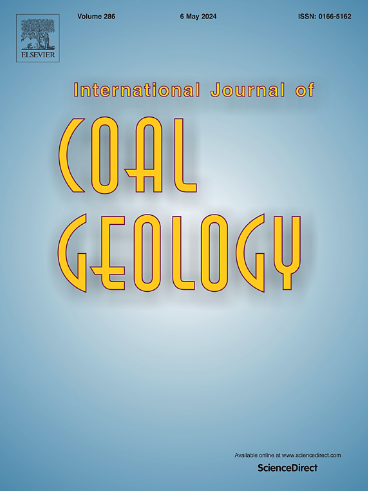西喀尔巴阡山脉Pieniny Klippen带中侏罗统黑色页岩沉积:有机质组成、热成熟度、沉积和古环境变化
IF 5.7
2区 工程技术
Q2 ENERGY & FUELS
引用次数: 0
摘要
采用显微鉴定分析、显微光度法、荧光显微光谱法、孢粉相分析、岩石热解和生物标志物地球化学等综合方法,确定了波兰和斯洛伐克西喀尔巴阡盆地Pieniny Klippen带中侏罗统Szlachtowa组有机质类型、物源、热成熟度和油气潜力的变化来源。此外,还重建了古环境条件和鞭毛藻囊生物年代学。从层状镜质组和改造镜质组群中可以很好地识别出第一旋回镜质组。它允许在0.74% VRo (0.04 - 0.10% SD)下测定热成熟度。虽然将孢子石和藻褐石的测量值与计算值λmax和Q650/500进行比较,结果存在明显差异,但两者的光谱荧光参数均表明藻褐石和鞭毛藻囊具有明显的相似性。样品中主要含有热成熟的有机贫型III型干酪根,由陆源的第一轮镜质组、层状镜质组、改造镜质组和脂质组(孢子质组)组成,并混合有与板藻质组相关的II型干酪根。这与岩石评估和生物标志物数据以及孢粉相组成一致,后者表明植物碎屑干酪根群优于孢粉和非晶组分。上石炭统至三叠纪、下侏罗统以及中侏罗统最下部盖层的风化侵蚀沉积岩,形成了改造、氧化、破碎的陆源有机质。与主要的本土陆源有机质一起,改造后的沉积地层为海相斜坡到深海平原的硅屑沉积和浊积沉积的形成提供了来源。在伸展活动构造背景下,沉积通量和浊流跳动来源于越级边缘斜坡、断界倾斜块体和恰尔什丁海脊。此外,对远洋沉积物的有机贡献包括浮游微生物,如鞭毛藻囊、有孔虫试验衬里,以及在较小程度上的裸生植物和关键生物。中侏罗统黑色页岩沉积可能发生在以杂岩-含氧陆架和缺氧-缺氧陆架为主的盆地过渡时期。Szlachtowa组的鞭毛藻囊显示了中侏罗世阿勒世至巴约西亚期的特征,在托瓦西亚和Bathonian期也出现了一些鞭毛藻囊。有机质保存的显著变化影响了研究的黑色页岩的生烃潜力,导致其低至中等的烃源岩生烃潜力(平均TOC为~ 0.6 wt%);氢指数平均值为~ 100)。本文章由计算机程序翻译,如有差异,请以英文原文为准。
Middle Jurassic black shale deposits from the Pieniny Klippen Belt, Western Carpathians: Insights into organic matter composition, thermal maturity, depositional, and palaeoenvironmental variations
An integrated multi-method research study, employing maceral identification and analysis, microphotometry, fluorescence microspectrometry, palynofacies analysis, Rock-Eval pyrolysis and biomarker geochemistry, and was applied to determine sources of variation of organic matter (OM) type, its provenance, thermal maturity, as well as hydrocarbon potential of the Middle Jurassic Szlachtowa Formation in the Pieniny Klippen Belt of the Western Carpathians in Poland and Slovakia. In addition, a reconstruction of paleoenvironmental conditions and dinoflagellate cyst biochronology were performed. The presence of first-cycle vitrinite was well-discerned from phyllovitrinite and a reworked vitrinite population. It allowed for determination of thermal maturity at 0.74 % VRo (0.04–0.10 % SD). Although a comparison between measured and calculated λmax and Q650/500 for sporinite and alginite yielded a marked discrepancy, both spectral fluorescence parameters illustrate a clear similarity between lamalginite and dinoflagellate cysts. The samples contain predominantly thermally mature organic-lean Type III kerogen of terrigenous-derived macerals of first-cycle vitrinite, phyllovitrinite, reworked vitrinite, and liptinite (sporinite) with admixture of Type II kerogen associated with lamalginite. This is in line with Rock-Eval and biomarker data as well as the palynofacies composition, the latter indicating predominance of phytoclasts kerogen groups over palynomorphs and amorphous components. The occurrence of reworked, oxidized, and fragmented terrigenous OM is attributed to weathered and eroded sedimentary rocks from the Upper Carboniferous to Triassic and Lower Jurassic periods as well as from the lowermost Middle Jurassic cover. Together with predominant primarily indigenous terrigenous OM, the reworked sedimentary strata served as a source for siliciclastic sedimentation and formation of turbiditic deposits in marine slope to abyssal plain settings. In the extensional active tectonic setting, sediment flux and runout in turbidity currents were derived from overstepped margin slopes, fault-bounded tilt blocks, and the Czorsztyn Ridge. In addition, organic contributions to pelagic deposits included planktonic microorganisms such as dinoflagellate cysts, foraminiferal test linings, and, to a lesser extent, prasinophytes and acritarchs. It is likely that the deposition of Middle Jurassic black shales occurred in a predominantly heterolithic-oxic shelf and dysoxic-suboxic shelf to basin transition. The Szlachtowa Formation yielded dinoflagellate cysts indicative of the Middle Jurassic Aalenian to Bajocian stages, with a few species also appearing in the Toarcian and Bathonian stages. Significant changes in OM preservation influenced hydrocarbon generative potential of studied black shales, accounting for its low to fair source rock generative potential (avg. ∼0.6 wt% TOC; Hydrogen Index avg. ∼100).
求助全文
通过发布文献求助,成功后即可免费获取论文全文。
去求助
来源期刊

International Journal of Coal Geology
工程技术-地球科学综合
CiteScore
11.00
自引率
14.30%
发文量
145
审稿时长
38 days
期刊介绍:
The International Journal of Coal Geology deals with fundamental and applied aspects of the geology and petrology of coal, oil/gas source rocks and shale gas resources. The journal aims to advance the exploration, exploitation and utilization of these resources, and to stimulate environmental awareness as well as advancement of engineering for effective resource management.
 求助内容:
求助内容: 应助结果提醒方式:
应助结果提醒方式:


